


Report
Initial Report
Spray Event
Whangarei District Council
23 December 2020
Classification: Restricted
This report is carried out in accordance with the following Incident Prevention Group
Documents:
Accident/Incident Reporting & Investigation IPG 12
© Incident Prevention Group 2016.
This document is the property of Incident Prevention Group (Ltd.) Circulation is restricted to Incident
Prevention Group, Whangārei District Council and its designated associates, subcontractors and
consultants. It must not be copied or used for any other purpose without the express permission of the
issuing company and Whangārei District Council. Incident Prevention Group (Ltd.) disclaims any
responsibility or liability for any use of or misuse of this document by any person (s) and makes no
warranty as to the accuracy or suitability of the information to any third party. Any misuse of the
document is redressible by Incident Prevention Group (Ltd) and Whangārei District Council.
Any enquiries about this publication should be sent to:
Incident Prevention Group (Ltd.)
Email: karl@ipg.global
41 Matai Street
Telephone: +67 7 376 7501
Taupo 3330
Website: www.ipg.global
This report is produced by the Karl Berendt, Managing Director, Incident Prevention Group (Ltd.)
Page
2 of
32
Classification: Restricted
Preface
The purpose of an Incident Prevention Group
(IPG) investigation is to improve
safety and/or company performance by preventing future incidents or by
mitigating their consequences. It is not the purpose of such an investigation to
establish blame or liability. Accordingly, it is inappropriate that IPG reports
should be used to assign fault or blame, determine liability or assign costs, since
neither the investigation nor the reporting process has been undertaken for that
purpose.
IPG’s findings are based on its own evaluation of the evidence that was
available at the time of the investigation and are intended to explain what
happened, and why, in a fair and unbiased manner.
Where IPG has described a factor as being linked to cause and the term is
unqualified, this means that the IPG has satisfied itself that the evidence
supports both the presence of the factor and its direct relevance to the causation
of the incident. However, where IPG is less confident about the existence of a
factor, or its role in the causation of the accident, IPG will qualify its findings by
use of the words ‘probable’ or ‘possible’, as appropriate. Where there is more
than one potential explanation IPG may describe one factor as being ‘more’ or
‘less’ likely than the other.
In some cases factors are described as ‘underlying’. Such factors are also
relevant to the causation of the accident but are associated with the underlying
management arrangements or organisational issues (such as working culture).
Where necessary, the words ‘probable’ or ‘possible’ can also be used to qualify
‘underlying factor’.
Use of the word ‘probable’ means that, although it is considered highly likely
that the factor applied, some small element of uncertainty remains. Use of the
word ‘possible’ means that, although there is some evidence that supports this
factor, there remains a more significant degree of uncertainty.
An ‘observation’ is an issue discovered as part of the investigation that is not
considered to be causal or underlying to the event being investigated, but does
deserve scrutiny because of a perceived potential for learning.
The above terms are intended to assist readers’ interpretation of the report, and
to provide suitable explanations where uncertainty remains. The report should
therefore be interpreted as the view of IPG, expressed with the sole purpose of
improvement.
IPG’s investigation (including its scope, methods, conclusions and
recommendations) is independent of any inquest, fatal accident inquiry or other
investigations, including those carried out by WorkSafe, the NZ Police, NZ Fire
Service, NZ Transport Authority or any other regulatory body.
Page
3 of
32
Classification: Restricted
Preface Cont.
The Incident Prevention Group follow, as our standard, the TapRooT® incident
investigation system.
The process follows a set format which has the following steps:
Plan
Determine Sequence of events
Define Causal Factors*
Determine Root Causes*
Develop Correct Actions (If part of the scope of the investigation)
Develop Report.
*There are certain terms which be referenced in this document which are stated
above and for the reader will be detailed to allow a more complete
understanding.
The TapRooT® Definition of a Causal Factor is,
“A mistake, error, or failure that
directly leads to (or causes) an Incident or fails to mitigate the consequences of
the original error.”
The causal factor will also be reviewed to determine if the event sits with Human
error or an equipment issue. In addition to this the investigation Team Leader
will also consider what the error was, were there opportunities to catch or stop
that error and were there opportunities to mitigate the consequences of that
error?
Once all Causal factors have been identified then the team will move onto
determining the Root Causes,
The TapRooT® system also provides a definition for this term. A Root Cause is,
“The absence of a best practice or the failure to apply knowledge that would
have prevented the problem, or significantly reduced its likelihood or
consequences”
If, as part of the investigation scope, corrective actions are to be developed the
team will use the SMART method, common throughout industry.
Page
4 of
32
Classification: Restricted
link to page 6 link to page 7 link to page 8 link to page 9 link to page 10 link to page 11 link to page 15 link to page 15 link to page 16 link to page 21 link to page 24 link to page 25 link to page 26 link to page 26 link to page 27 link to page 28 link to page 36 link to page 41 link to page 49
Whangārei District Council
Spray Event
Contents
Figures
6
Key points
7
Introduction
8
Summary
9
Key Facts and Analysis
10
Reporting of event
11
Initial Findings.
15
Events on the day / Operator - Vehicle
15
Location of vehicle
16
Spaying as a practice.
21
Potential Risk.
24
Our recommendations.
25
Appendices
26
1.0 Abbreviations
26
2.0 References
27
3.0 VC06 Roadside Vegetation Spraying
28
4.0 Complaint Received
29
5.0 Statement
30
6.0 Fleetpin Report
31
7.0 Information Monsanto Science Direct
32
Page
5 of
32
Classification: Restricted
Figures
Figure 1. Location of Incident ……….. .....................................................................................
9
Figure 2. Quad bike spraying arm……………………………………………………………………
11
Figure 3. Photo 1
......................................................................................................
12
Figure 4. Photo 2
......................................................................................................
13
Figure 5. Photo 3
. ....................................................................................................
13
Figure 6. Section taken from Page 4 of Fleetpin Report...........................................................
16
Figure 7. Section taken from Page 6 of Fleetpin Report...........................................................
18
Figure 8. Blow up of Figure 3....................................................................................................
19
Figure 9. Section from Page 5 Fleetpin Report ……………………………………………………
19
Figure 10. Compass showing direction of Mill Road and the wind. ……………………………..
20
Figure 11. Sectio taken from ArgiPro 510 SDS ........................................................................
22
Page
6 of
32
Classification: Restricted
s
oint
y P
Key points
Ke
a.
Metric units are used in this report, except when it is not normal practice. If, as with
many industries, an imperial unit is used as a recognised standard then an appropriate
and equivalent metric value is also given.
b.
All times are stated in 24 hour clock format to avoid confusion.
c.
The report contains abbreviations and technical terms (shown in italics the first time
they appear in the report). These are explained in Appendix 1.
d.
Any text that is copied from a source or a piece of evidence is shown in Italics to show
that this is not the writers wording.
e.
Any relevant sections from Acts, Standards, Guidelines, Best Practice Guidelines or
other relevant industry documentation is listed in a separate appendix.
f.
We would like to thank all the following companies and organisations; Downers NZ,
Northland Transport Alliance, Northland Toxic Awareness Group and various others
who were involved in the writing of this report.
Page
7 of
32
Classification: Restricted
on
ducti
Introduction
Intro
1.
On the 11th of April 2022 at 1542 hours the writer was contacted by Jeff Devine,
Strategy & Planning Manager for the
Northland Transportation Alliance (NTA), who is
based at its main office in Whangārei. The NTA is a partnership between all four
councils within Northland and
Waka Kotahi (NZTA).
2.
Mr Devine stated that the Alliance had received a complaint from a member of the
public.
3.
Mr Devine went on to state that the complaint was related to an event when a Sub-
Contractor of its Head contractor, Downer NZ, had been weed spraying from a quad
bike, and has allegedly sprayed the feet of children who were walking along Mill Road
4.
He asked if the
Incident Prevention Group (IPG) and the writer Mr Karl Berendt could
assist the Alliance with an investigation and then delivery of a report for the above
event specifically, also the suggestions on the overall use of weed spraying as best
practice on weed control within the NTA network.
5.
Relevant paperwork was duly sent to Mr Devine regarding engagement and IPG was
formally engaged on Wednesday the 20th of April 2022.
Page
8 of
32
Classification: Restricted
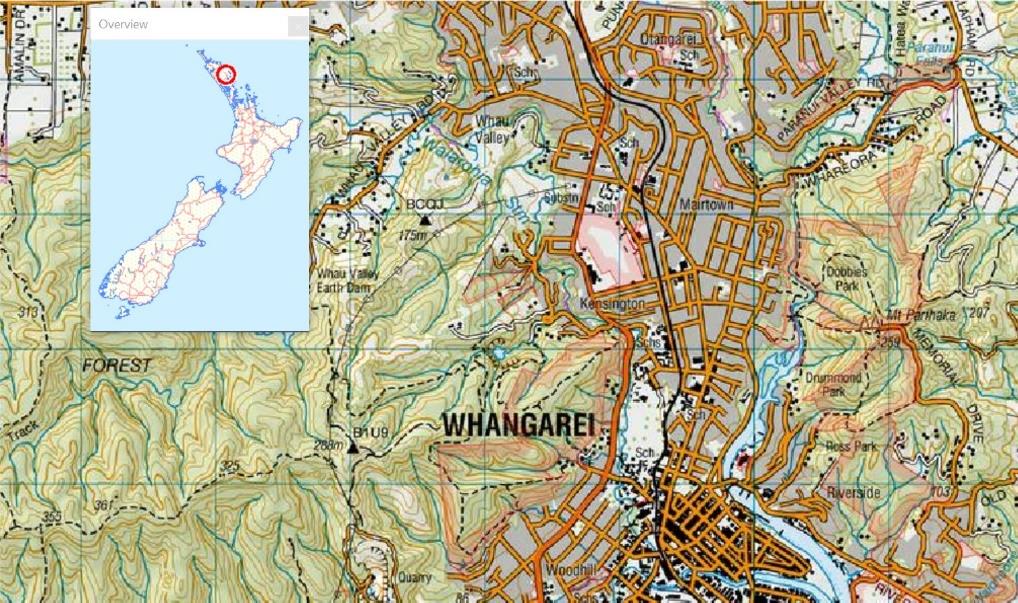

ary
m
Summary
Sum
6.
On the 21st of October 2021 the
Northland Transportation Alliance (NTA) received a
complaint via the Whangārei District Council email system.
7.
The Alliance contracted Downer NZ to provide a range of services to the road network
in the Northland region. This also included the use of Sub-Contractors for sections of
work.
8.
Part of this Sub –Contracted work was for vegetation control. The company who have
sub-contracted this section of work is
Team Vegetation (TV) based in Dargaville.
9.
The company has developed a specialised quad bike with a spraying arm that is used
to spray the edge of roads where the footpath meets the concrete kerb.
10.
Team Vegetation predominantly use a product called Agpro Green Glyphosate 510
The base for 510 is a generic weed killer called Glyphosate.
11.
On the Thursday the 21st of October 2021 the Whangārei District Council mailroom
received a complaint about the weed spraying that had occurred on Mill Road from
Coordinator of the
Northland Toxin Awareness Group (NTAG)
12.
It was stated in this email that one of the operators from Team Vegetation had sprayed
over the feet of three children who were walking down Mill Road.
13.
Initial meetinmgs were undertaken by the NTA and it was then passed to IPG to
investigate the matter further.
Figure 1:
Location of Event
Lat: 35°42'29.21"S
Long: 174°19'30.72"E
Page
9 of
32
Classification: Restricted
lysis
na
A
Key Facts and Analysis
acts and
1.
On the 21st of October 2021 the Northland Transportation Alliance (NTA) received a
y F
Ke
complaint via the Whangārei District Council email system.
2.
The Alliance is a collaboration between Kaipara District Council, Whangārei District
Council, Far North District Council, Northland Regional Council and Waka Kotahi
NZTA to deliver combined services for roading and transportation in Northland.
3.
To undertake work the Alliance contracted Downer NZ to provide a range of services
to the road network in the Northland region. This also included the use of Sub-
Contractors for sections of work.
4.
Part of this Sub –Contracted work was for vegetation control.
5.
An Expression of Interest was called for. The work to be undertaken was included in a
document that detailed two sections required for the work. These were issued in 1
word document and had section headings of, VC06 Roadside Vegetation Spraying
and VC07 Spot Vegetation Spraying. See Appendix 3
6.
One of the respondents was a company called Team Vegetation with headquarters at
103 Beach Road in Dargaville. The company is owned by Mr Hamish Campion.
7.
Ultimately, after due process Team Vegetation were selected as the preferred
contractor to Downer and then onto NTA. This contract was awarded in September of
2018.
8.
The Downer Contract Manager stated that they have been doing this type of work for
many years. This was confirmed by a check of the company records showing they
were registered on the 16 May 2017, but had previously traded as Compass
Vegetation Control,
9.
A description on their web site states that “TEAM Vegetation delivers complete
vegetation management solutions to commercial, public and private properties. Having
spent nearly six decades practicing and perfecting the retail and contracting sides of
vegetation solutions”
10.
Team Vegetation has, also according to their web site
, “some of the most advanced
and capable roadside spraying equipment in the industry having been involved in the
pioneering of the roadside spraying methodology and with the skills and expertise to
make all their own specialized equipment”
Page
10 of
32
Classification: Restricted
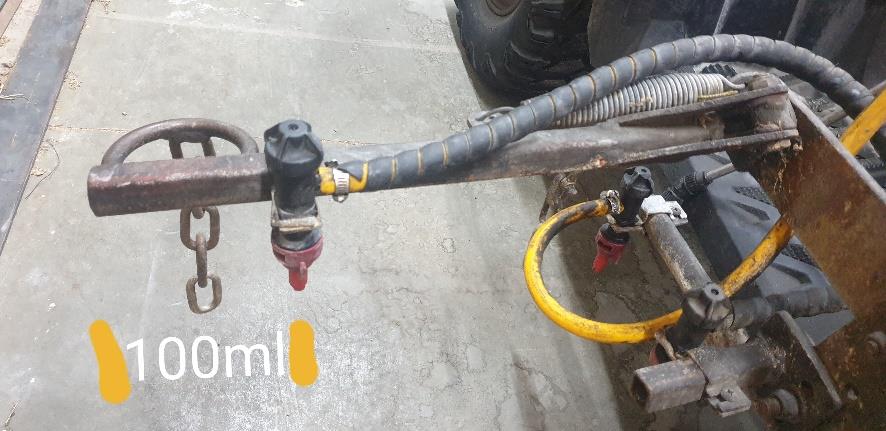
lysis
na
A
11. As part of this specialised equipment, they have developed a specialised quad bike
with a spraying arm that is used to spray the edge of roads where the footpath meets
acts and
the concrete kerb. See Picture 2 Below
y F
Ke
Figure 2:
Quad bike spraying
arm
12. Team Vegetation use product called Agpro Green Glyphosate 510, manufactured and
supplied by Agpro Direct, a chemical company based in East Tāmaki, Auckland. The
base for 510 is a generic weed killer called Glyphosate, a product originally developed
by the Monsanto Company in 1970. For further details please see appendix 7
13. Glyphosate is a non-selective, non-residual herbicide for control of a wide range of
weeds in forestry and industrial/wasteland areas (as taken from the Agripro 510 web
page)
Reporting of event
14. On the Thursday the 21st of October 2021 the Whangārei District Council mailroom
received a complaint about the weed spraying event that had occurred on Mill Road
from
, Coordinator of the Northland Toxin Awareness. See Appendix
4
15. It was stated in this email that one of the operators from Team Vegetation, who was
operating a quad bike with the specialised spray head, as shown in Figure 1 above,
had sprayed over the feet of three children who were walking down Mill Road on or
around 4pm on Wednesday the 20th of October 2021.
16. While the report to council was initiated by
, the incident was actually
witnessed by
. See statement Appendix 5
17.
made contact with
due to her role as contact person for the
NTAG.
18. On the NTAG Facebook page there is a post by
, on the 21st of October
2021, stating that on the previous night she had been contacted by
with the
information in her statement.
Page
11 of
32
Classification: Restricted

lysis
na
A
19. In her statement
detailed the following events “
On Wednesday the 20th of
October 2021 I pulled over and parked before Young's Supermarket on 61 Mill Road
Whangarei 0112 at 4pm. I saw a spraying contractor on a quadbike come up behind
acts and
y F
me. As he was passing my car and went back to the curb, he immediately started to
Ke
spray. Three children were walking on the sidewalk away from the supermarket (see
attached exhibit A) – Writers note: See figure 3 below for more detail -
The spraying
contractor did not stop the spray jet when passing the children, nor did he swerve to
avoid them. but he sprayed right over their feet and kept going”
20.
provided three photographs taken on her Samsung Galaxy S7 SM-G930F
phone. These are designated as serial numbers 20211020_155327 taken at 1553
hours on the 20th, 20211020_160540 and 20211020_160543 both showing the time
stamp of 1605 hours on the 20th. These are shown below as figures 3, 4 and 5 below.
Figure 3:
Photo 1 from
Page
12 of
32
Classification: Restricted
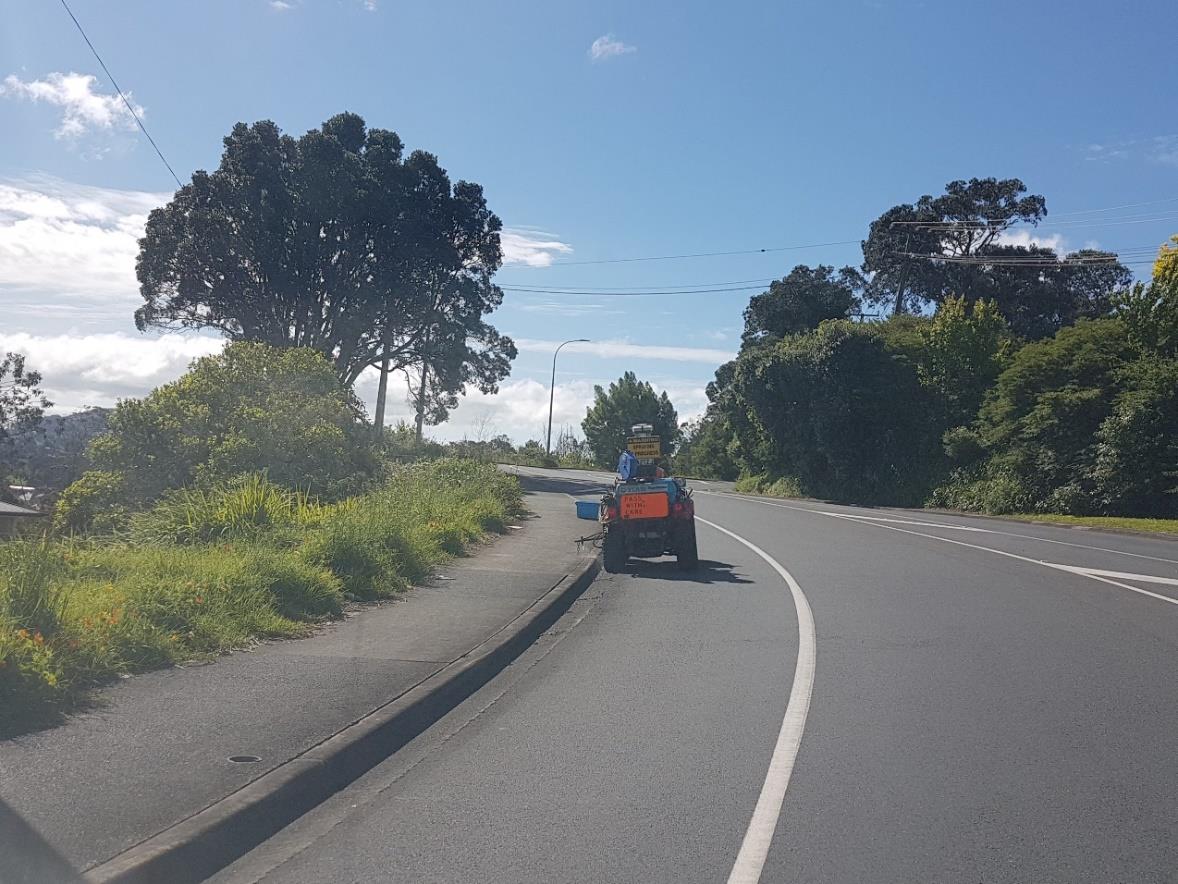
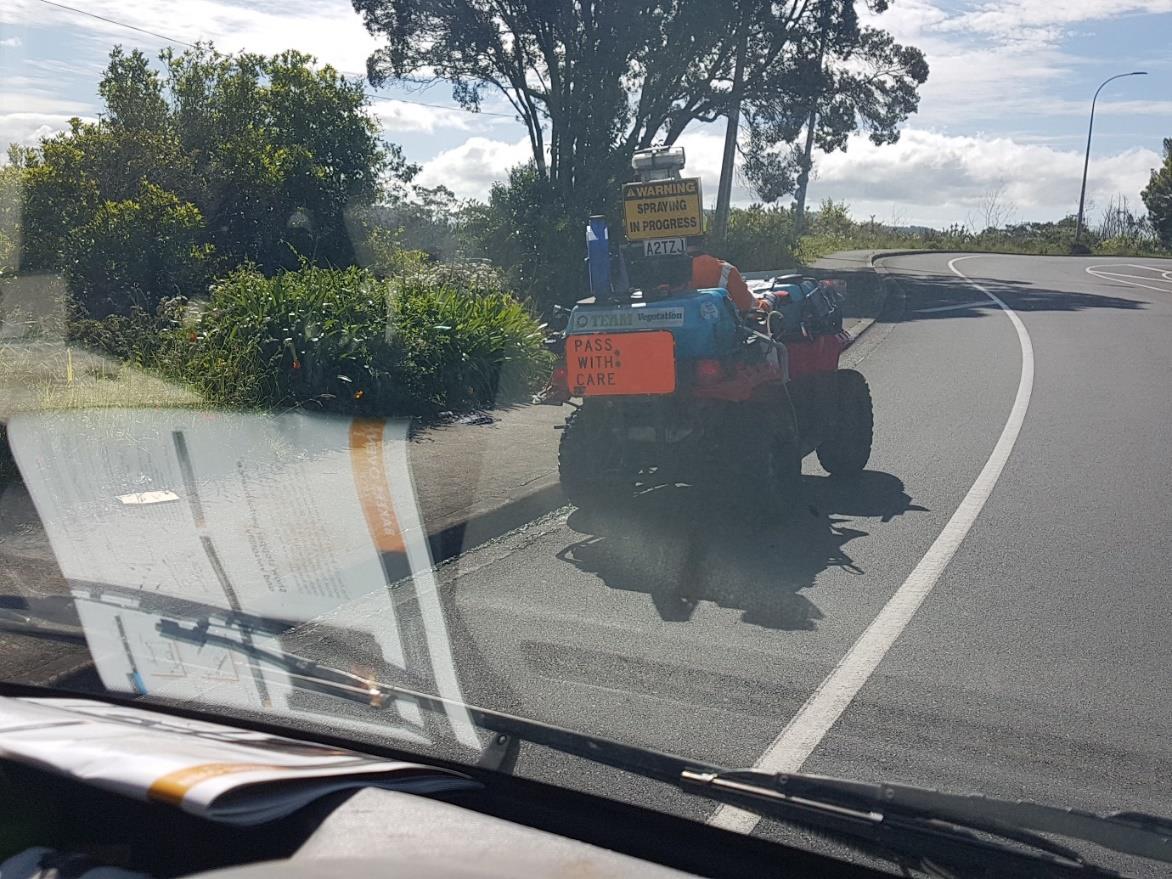
lysis
na
A
acts and
y F
Ke
Figure 4:
Photo 2 from
Figure 5:
Photo 3 from
21.
report was first directed to the council mail room and was received by
them on Thursday, October 21, 2021 1:15 PM, it was also cc’ed to the Mayor and to a
Councillor Ms Anna Murphy.
Page
13 of
32
Classification: Restricted
lysis
na
A
22. This was also received by Ms Elsa Hunt,
Executive Assistant to Mayor and Deputy
Mayor (EA Mayor).
acts and
y F
23. This report then went from EA Mayor to Mr Jeff Devine,
Strategy & Planning Manager
Ke
NTA (SPMNTA)
24. Once it reached the SPMNTA a further email was sent to Mr Mike Batchelor,
Maintenance Lead NTA (MLNTA)
25. It was from this point numerous other parties were involved.
26. On the 22 October 2021 the MLNTA contacted Downer and other partiers, via email,
to arrange a meeting to discuss the alleged event and this was scheduled for the 27th
of October.
27. It was stated by the MLNTA that this was not and investigation just a meeting to disciss
the events on the day.
28. On the Wednesday the 27th October there was a meeting held, and it consisted of the
following attendees: David Peter – Downer, Paul Rountree - TEAM Vegetation Ltd,
Hamish Campion - TEAM Vegetation Ltd, Buster Sandford – Downer, Rachel Taylor –
Downer, Adam Hodgson – Downer, and Mike Batchelor – NTA.
29. No official minutes were taken from this meeting but as stated above in section 27, this
was not part of an investigation. NOTE: While the writer attempted to locate the
children, due to sensitive nature of this report general public enquiries were not made.
As such, the writer was not able to interview them or their parents/guardians.
Page
14 of
32
Classification: Restricted
lysis
na
A
Initial Findings.
Events on the day / Operator - Vehicle
acts and
y F
Ke
30. As with any investigation, we build a simple time line for the event, along with relevant
information for parties involved.
31. The writer has been advised that Mr Card has been with the company since 2019 and
has been, since starting, actively involved in the spraying of verges using quad bikes.
32. Further information from the TV
General Manager (GM), Mr Paul Rountree, stated that
Mr Card has been trained by the company in the use of chemicals and is also well
versed in the mixing and application of the product he was using.
33. TV GM also went on to add that Mr Card is in fact the only person who is charged with
verge spraying inside the Whangarei urban area.
34. As is usual, Mr Card began his day with the mixing of a load for his quad bike of the
specified product, Agpro Green Glyphosate 510. This was completed at the company’s
home base. The typical dilution rate, taken from the label on a 20 litre Agpro510
container, is 0.7 percent of volume of water.
35. Mr Card then left his base on his quad bike to undertake spraying in and around the
Whangarei town area.
36. The TV GV reports that the operators day was without event and he covered the
following areas in the Whangarei town; various roads off Kensington Avenue, Mill Road
up to the Tikipunga main road, including Whareora Road
37. From the limited data before the event, it seems as though the operator entered Mill
road via Nixon Road, after completing work in and around other areas in the CBD
including Port road.
38. The operator then travelled up Mill road completing work.
39. After leaving the Mill Road area the Operator then continued north until arriving at
Radcliffe Street. He then parked outside number 2 Radcliffe for a period of time.
40. This was to obtain assistance for a flat tyre the quad bike had. To repair this, a local
company was contacted, Gas and Tyre located in Port Road. This was a site call and
repairs were made.
41. Once this was completed the Operator carried on working.
Page
15 of
32
Classification: Restricted
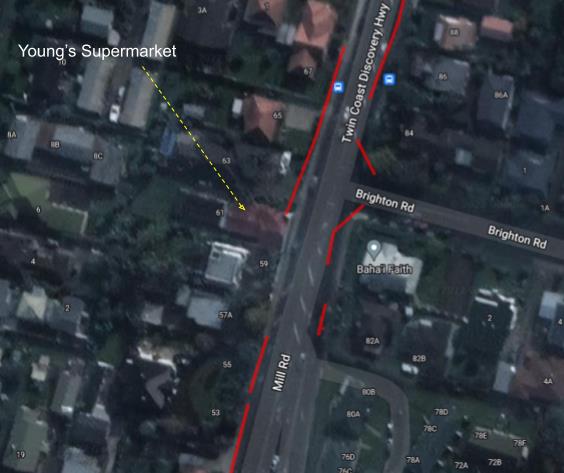
lysis
na
A
Location of vehicle
acts and
42. TV supplied evidence to the writer that suggests the Operator was not near the children
y F
Ke
on Mill road when the events took place and in fact was further up Mill road where it
transitions into Kiripaka Road. A photograph along with a data log, based on initial
information supplied, shows the location of the vehicle as outside no 25 Kiripaka Road.
43.
Note: Evidence was presented by the TV team that included data from a GPS based
unit on the bike in the form of a data tracker on the spray pump, described by the
supplier as an input, which shows when the spray pump was started and stopped.
More will be covered on this later in this report. This was originally supplied by TV but
further information was received in a report from Fleetpin dated 29 November 2022.
44. Having reviewed the data presented to the writer and having reviewed data supplied
by Fleet pin, and research on the Vodafone network, it is probable Kiripaka Road was
not the location of the quad bike at the time of the incident
45. As the data from
phone is time logged, at the times mentioned in section
20 above, it is probable that the Operator was in fact nearer the location of the children
than to Kiripaka Road.
46. In support of this, smartphones get the time from the cellular network and/or GPS. GPS
satellites have atomic clocks on-board, which is why they are such a good source of
raw, reliable time data. (There are slight variances between the camera data and the
GPS data but it is not significant)
47. Data was also presented by Mr Todd McCormack, Director/CEO Fleetpin Limited, in
his report dated 29/11/2022 that is relevant (See appendix 6).There are two pieces of
evidence that support the fact that the operator was near Young’s supermarket at the
time of the incident.
48.
First, Fleetpin on page 4 of their report show the following picture and associated text
Figure 6:
Section Taken from
Page 4 of Fleetpin
Report.
Page
16 of
32
Classification: Restricted
lysis
na
A
49. The Input report and associated image above shows that the Spray pump was
switched;
acts and
On, at the southern end of 51 Mill Road.
y F
Ke
Off, at the northern end of 53 Mill Road at a vehicle entrance. (time on 13s)
On, at the southern end of 55 Mill Road at the same vehicle entrance
mentioned above.
Off, at the northern end of 55 Mill Road. (time on 8s)
On, at the northern end of 61 Mill Road, northern end of Young’s Supermarket
Off, in the middle of 67 Mill Road. (time on 21s)
50. Using the data also from the Fleetpin report it states that the positioning does have a
variance of 2.5 metres and detail of this statement is shown below with relevant notes.
51. The horizontal accuracy of the device fitted has a CEP of 2.5m 1, therefore it would be
expected that 50% of the time under good operating conditions it will have a horizontal
accuracy within 2.5m.
52. The accuracy of the GPS device and the Land Information Satellite map used can be
seen by the position of the red line in the satellite image on the previous page. The red
line represents the GPS device located near the centre of the ATV, therefore as the
vehicle is being driven on the road, beside the kerb you are able to see the relative
accuracy at different points, (within a few metres of the roadside on most occasions)
53.
Looking at the GPS Satellite signal strength, the horizontal dilution of position (HDOP)
2 is on average 0.7, which is very good, and the satellite numbers benign 12, which is
also good, therefore the positions would be deemed to be within the CEP values.
1
Circular Error Probability or CEP is defined as the radius of a circle centred on
the true value that contains 50% of the actual GPS measurements. So a
receiver with 2.5 metre CEP accuracy will be within 2.5 metre of the true
measurement 50% of the time. 2 T
he effect of the DOP (dilution of precision) on the horizontal position value. The
more good visible satellites low in the sky, the better the HDOP and the horizontal
position (Latitude and Longitude) are.
54. Second. The Fleetpin report also shows the tracking of the vehicle using the data
coming from the unit.
55. Again referencing the Fleetpin report, page six, it states.
It is noted on the view that shows the track of the ATV using the ignition input, (input
1) that the ATV appears to have followed the roadside kerb, even when the spray pump
switch was turned off. This is evidenced by the track curving into what appears to be
the car parking area outside Young's Supermarket, it is also noted by the yellow pins
Page
17 of
32
Classification: Restricted
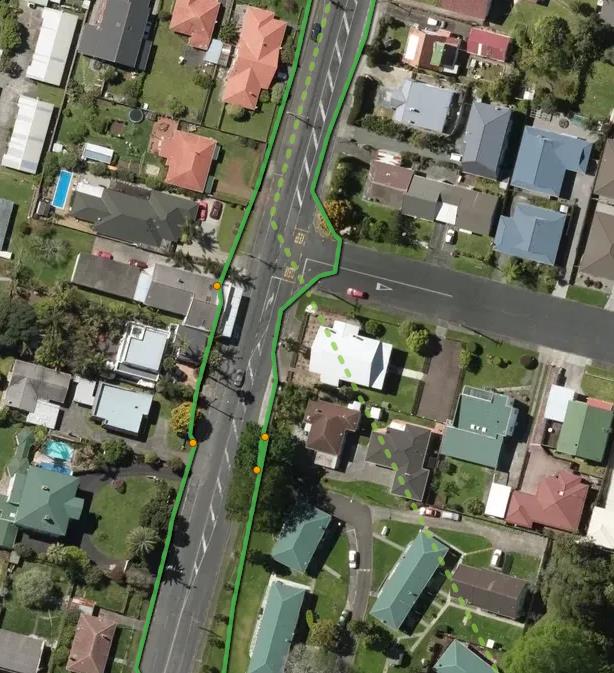
lysis
na
A
on the satellite image (Writers Note – this picture is shown below)
that the vehicle was
stopped momentarily at these pin positions.
acts and
Figure 7:
y F
Ke
Young’s
Section Taken from
Supermarket
Page 6 of Fleetpin
Report.
56. While some time is spent in this report determining the location of the operator, this is
merely to confirm if the event could have taken place.
57. It is the writers opinion, with evidence presented, that the vehicle was near the incident
site in Mill Road on the day in question. With regards to the spraying of the children
please see sections below to provide further detail on this.
58. With regard to the matter of the operator spaying the children, the following needs to
be considered.
i. Location of the spray head – from figure 3 above, we can see that the spray
head is 100mm from the end of the boom. Using this as a reference, an
estimation can be made that the spray nozzle is approx. 150mm above the
ground and the spray area is approx. 200mm across.
ii. Due to the set up and more importantly, the angle of the nozzle, the majority
of the spray is towards the machine. (See figure 8 below, blow up of figure 3)
Page
18 of
32
Classification: Restricted
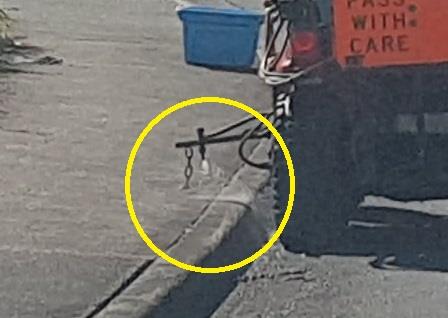
 s
Figure 8:
Finding
s
Figure 8:
Finding
Blow up of Figure 3
59. The way the spray boon is set up, again referencing photo 2 from
the boom
has an end on it which has a chain and a hoop. This prevents anything coming in
contact with the nozzle.
60. For there to have been a direct spray onto a subject, that subject would had to have
been in front of the boom arm. Had this been the case with the children in question,
they would have been struck by the boom. A situation that would have been
immediately noticeable to the driver and possibly even the witness, based on evidence
this did not occur.
61. This leaves the issue about how spray could have come in contact with the children,
as described by the witness.
62. Using information from the witness photos and crossing this over with Google earth we
able to establish that the
photo is taken when the children are approx. 45
metres from the front door of Young’s supermarket.
63. If we take the average speed of a child strolling as 3 kph then the children had taken
1 min and 3 seconds to get to where they are in the photo.
64. Deduct this from the time stamp on photo 1 of 1553 hrs this would make the time of
them leaving Young’s to be 1551.hrs
65. As detailed in the Fleetpin report the pump was switched on at 1551 hrs (See below)
Figure 9:
Section from page 5 Fleetpin Report
Page
19 of
32
Classification: Restricted
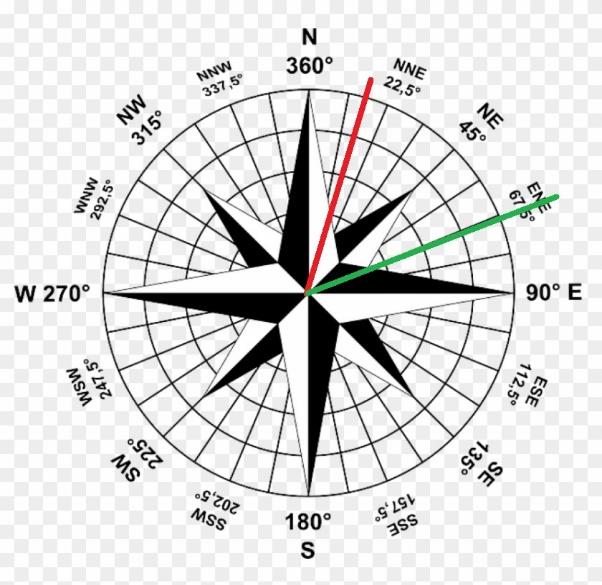 s
s
66. The writer believes that there is now evidence to suggest that the unit was near the
Finding
children at the time of the alleged event.
67. Next the writer has tried to determine how the spray may have made contact with the
children.
68. The next item the writer considered is the weather. Using historical data from the web
site Weather Underground and based on data from a recording station is located at
the Whangarei airport. The writer acknowledges this is some distance from Mill road
but does give a general wind pattern for the area.
69. Using the web site the following has been discovered, the wind on the day increased
between 1500 hrs and 1600 hrs from 0 to 14 kph with a wind direction of East North
East (ENE)
70. Mill road is aligned at approx. 15 degrees (deg) from north (displayed by the red line
in compass picture below) and ENE is at 65.5 deg (displayed by the green line in the
compass picture below
Figure 10:
Compass showing direction of
Mill Road and the wind.
71. With a wind of this amount, and the angle described above, it is possible that there has
been some over spray.
72. It is the writer’s opinion, that there has not been a direct spray event over the children,
but there exists a possibility that over spray may have occurred and it was this that the
witness saw.
73.
This would support both statements, from the operator and the witness.
Page
20 of
32
Classification: Restricted
s
Part Two
Finding
Spaying as a practice.
74. With the initial consultation that was held between the writer and Mr Devine, IPG was
requested to look at two separate areas.
75. The first was the event itself. This has been covered above, and the practise of
spraying glyphosate in the broader context.
76. The writer is not a specialist chemist and has had to rely on data sourced from many
different sources.
77. These range from official documents, such as safety data sheets, advice from the
manufacturers and from various papers on the Science Direct.com web site, a common
reference resource used by the writer.
78. It is important to note that information from official sources was limited to the actual
makers of the original product. Attempts were made to access the Monsanto site, the
original patent holders, however this web site has been shut down.
79. Monsanto was purchased by a German company, the Bayer Group, in 2018 and
references were made to this web site for information.
Glyphosate
80. The writer would like to add that with any controversial issue there are strong
sentiments on both sides, and as such this has been taken into account when dealing
with various persons.
81. It is interesting to note that glyphosate had been with us for some time having originally
being developed in the 1950’s with the first patent issued in 1964. This was lodged
with the patent office in the USA for use as a metal chelating and descaling agent in
order to clean out mineral deposits in pipes and boilers.
82. Later work with Monsanto led to glyphosate being patented as a herbicide in 1971, and
introduced into the pesticides market in 1974, as a pesticide active principle under the
trade name “Roundup®.”
83. While this means it has been in use for a period of 58 years, its real leap forward
occurred in 1991 when the original patent period ended, the one being held by
Monsanto, allowing generic products to be produced. Since then it has become the
world’s leading herbicide. It is estimated that approx. 8.6 billion kilograms has been
used worldwide since its inception.
84. Research by the writer has found that information about the glyphosate is strangely
not that prevalent and what was found included extreme views on both sides of the
fence.
85. One person spoken to stated, is was completely harmless and that any spray levels
even over children is harmless. When asked if they were happy for me to cite that in
my report they declined and asked that I did not contact them again.
Page
21 of
32
Classification: Restricted
 s
s
86. Others state that even small amount of product could have devastating consequences.
Finding
87. The issue found by the writer, was that oddly enough, no definitive study or trial has
been conducted with glyphosate in the 54 years it has been on the market.
88. While there are many thousands of pages related too many so called independent
tests, there is still, no clear cut single source independent peer reviewed report dealing
with either the effects of raw product or mixed products.
89. With this said, there is reference to the effects on marine life and this is included in the
Safety Data sheets for any Glyphosate products.
90. Even if we review the Safety Data Sheet for the Agripro 510 product itself, See extract
below. There are large sections where no toxicology data is available.
F
igure 11:
Section taken Agripro 510 SDS.
91. As stated above there is vast ranges of conflicting data. For as many reports the writer
found with reference to this product being safe, there were just as many that stated it
was unsafe.
92. The writer looked at this issue with regard to what external agencies have looked at
this matter and what have they reported.
93. The most compelling has come from the
International Agency for Research on
Cancer
(IARC) which is part of the
World Health Organisation (WHO). They complied a study
titled “IARC Monographs1 on the Evaluation of Carcinogenic Risks to Humans” issued
in 2017, numbered as Mono 112.
94. This has the sub title of
“ Some Organophosphate Insecticides And Herbicides”
As part of this report on page 398 the report states the following;
Page
22 of
32
Classification: Restricted
s
6.1 Cancer in humans
Finding
There is
limited evidence in humans for the carcinogenicity of glyphosate. A positive
association has been observed for non-Hodgkin lymphoma.
6.2 Cancer in experimental animals
There is
sufficient evidence in experimental animals for the carcinogenicity of
glyphosate.
6.3 Overall evaluation
Glyphosate is
probably carcinogenic to humans (Group 2A).
95. It must be noted that this differs from a report issued by the United States
Environmental Protection Agency’s Office of Pesticide Programs dated 2017 and titled
Glyphosate Issue Paper: Evaluation of Carcinogenic Potential. This report, as
described by one writer Dr. Charles Benbrook, is diametrically opposed to the report
from WHO.
96. In an article by Dr Benbrook published in 2019 he details how this different view could
have occurred.
97. The writer is comfortable that an organisation such as the WHO is a reliable
organisation and that the work appears sound.
98. It is interesting to note, that information found by the writer, from interviews, has
presented that Monsanto has been through a legal case related to the use of
RoundUp® and the development of non-Hodgkin lymphoma.
99. The difference is that this relates to the use by adults and over a period of time. The
mix ratio for the above case was not reviewed.
100.
In discussions with Dr Merril Watt, the one comment made by the Doctor was,
“what is an acceptable limit of exposure for a child” A valid question posed by the
Doctor but it is the writers opinion, this may never be known.
101.
With the information reviewed by the writer, it is the writer’s opinion that there
is evidence to support the possible harmful effects from glyphosate. The writer is not
suggesting that the development of cancers is certain but there is a risk, as stated in
the WHO report. This will be detailed further below.
1 Monograph - a detailed written study of a single specialised subject or an aspect of it.
Page
23 of
32
Classification: Restricted
s
Potential Risk.
Finding
102.
As with any hazard we deal with in industry, we need to look at the following
with regards to the risk it presents to the company.
103.
To do this we look at the two legs of a risk matrix;
1. What is the potential outcome of this exposure to the hazard? (This will help us
to determine what controls measures need to be applied to mitigate the hazard)
2. What is the likelihood that the consequences will occur?
104.
It is the writer experience that likelihood is based on industry standards. For
example in the offshore drilling area there is extensive knowledge of the hazards that
oil and gas workers deal with and the frequency of these events. Mainly due to high
levels of reporting.
105.
In respect to this hazard, the likelihood is difficult to determine. What has been
discovered during the course of this investigation is that there is the potential of an
unfavourable outcome.
106.
It is the writer’s opinion that with the high consequence, the matter needs to be
looked at in two ways. The risk from the hazard itself and the risk to the business as a
whole.
107.
First the hazard itself (related to the use of glyphosate itself) – It is the writers
opinion that this is covered above.
108. The risk to the business – The writer has approached this from the following point of
view, is there a way to limit the company’s exposure to possible further backlash and
other possible issues from this, and other future events.
(The writer must state that he was contacted by
regarding another event,
where she wanted this event added to this report. This was declined by the writer as
it fell outside the scope of the writer’s engagement).
109. The writers has thought back to other products, that were later discovered to contain
a risk to people, and how this later became an issue for some companies.
110. With that in mind, and while we do not known the future for glyphosate, we do know
that Monsanto did settle the law suit stated above in section 90. Also when Bayer
took over they also accepted, as part of the purchase, the acceptance of a multi-
billion dollar claim which was with Monsanto at the time of the sale.
111. With this in mind, it is the writer’s opinion that distancing the various parties involved
with the NTA from this would be prudent.
Page
24 of
32
Classification: Restricted
 s
Finding
s
Finding
112. Using the hierarchy of controls issued by Worksafe, the top of the list is to eliminate
the risk by removing the hazard or the people.
Our recommendations.
1. It is the writer’s recommendation that the use of an alternative to Glyphosate products
should be explored.
2. The writer has explored alternative options and there appears to be other products and
methods of control that could be utilised.
3. The writer accepts that some of these may come at a higher cost, but it is possible that
this could be beneficial to the NTA and the Council as a useful marketing tool to bolster
public support, but more importantly shield its self from any further flare up on this
issue.
Karl Berendt
Incident Prevention Group.
Page
25 of
32
Classification: Restricted
s
ndice
Appendices
ppe
A
1.0 Abbreviations
Deg
Degrees
Executive Assistant to Mayor and
EA Mayor
Deputy Mayor
GM
General Manager
GPS
Global Positioning System
HDOP
Horizontal Dilution of Position
HSWA 2015
HSWA 2015
International Agency for Research
IARC
on Cancer
IPG
Incident Prevention Group
Kg’s
Kilograms
Kph
Kilometres per Hour
LTSA
Land Transport Safety Authority
MLNTA
Maintenance Lead NTA
NTA
Northland Transportation Alliance
NTAG
Northland Toxin Awareness Group
Waka Kotahi - New Zealand
NZTA
Transport Agency
SPMNTA
Strategy & Planning Manager NTA
TV
Team Vegetation
WHO
World Health Organisation
Page
26 of
32
Classification: Restricted
s
ndice
ppe
2.0 References
A
https://agpro.co.nz/product/agpro-forestry-weedkiller-510
https://www.sciencedirect.com/topics/earth-and-planetary-sciences/glyphosate
https://doi.org/10.1186/s12302-018-0184-7
https://enveurope.springeropen.com/articles/10.1186/s12302-018-0184-7
https://www.ncbi.nlm.nih.gov/pmc/articles/PMC1193922/#:~:text=This%20speed%20is%20a
bout%202,of%20age%20and%20in%20adults.
Page
27 of
32
Classification: Restricted
s
ndice
3.0 VC06 Roadside Vegetation Spraying
ppe
A
Page
28 of
32
Classification: Restricted
VC06 ROADSIDE VEGETATION SPRAYING
General
Roadside Vegetation Spraying is defined as the herbicide spraying of roadside and edge
vegetation.
Work to be completed in accordance with the specific requirements set out below and the
NZTA C21:1997 specification.
Scope of Work
The following sets out the scope and extent of work that is expected when undertaking this
activity.
Extent of work
As detailed below, spraying will be carried out at the Engineer's discretion which may be
subject to climatic and financial constraints. The Contractor will supply all chemicals, labour
and equipment to perform the requirements of this specification and be a certified spray
applicator.
Spraying is to be carried out in three periods repeated yearly at an average of 2m from edge
of seal, or edge of formed road and shall include watertable or side drains. The three
periods are to be agreed in the annual programme.
Schedule of Spraying Zones
● The Contractor will develop a schedule of spaying zones populated into the RAMM
UDT table within the first 6 months of the Date of Acceptance. The Engineer will
provide an initial list of zones. The Contractor shall recommend and get approval for
the UDT data structure from the Engineer.
● The final schedule in RAMM shall be approved by the Engineer and then used to
create the future dispatches for Weed Spraying.
Roadside spraying
Control of roadside vegetation is required for several reasons which include driver safety,
visibility, unobstructed roadside furniture (such as guard/sight rails) and roadside drainage.
If the frontage is maintained by the property owner to Council's satisfaction and marking
the areas with `NO SPRAY' signs or marker posts or designated green RRPMs, these areas
are not to be sprayed.
Chemical control is excluded from use in the following areas:
● Where erosion of the bare surface is proven to be a problem, for example in
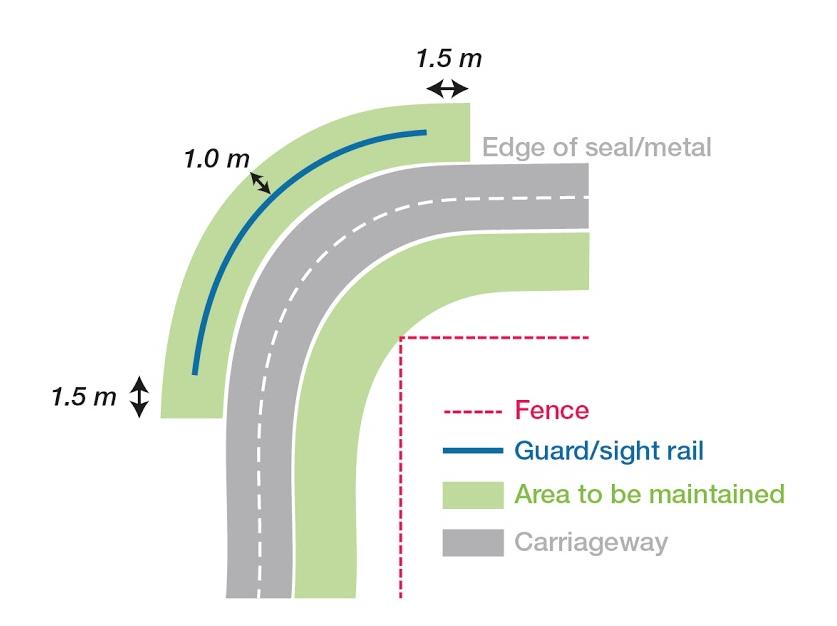
watertables or on embankments.
● Banks either above or below the road which have vegetation growth to retain
stability or have been hydroseeded shall not be sprayed.
The Engineer reserves the right to vary the quantities and scheduled roads.
The Contractor is to ensure that vegetation around guard/sight rails and the inside of curves
are to be eradicated according to the standard outlined in
Figure 4 below:
Figure 6: Vegetation control around guard/sight rails and sight
distance on insides of curves
●
Rural Areas Shall Include:
○ Roadside Spraying
■ All sealed and unsealed roads will be sprayed a minimum width of 2m
from the seal edge extending out to the back of the watertable.
■ Roadside furniture within the spray area, including guardrails, sight
rails, sign posts, delineators and traffic islands will be sprayed around
in such a way so that they are clearly visible to the motorist. Tra
■ All watertables adjacent to the roadside are to be sprayed.
■ All culvert inlets and outlets are to be sprayed in the same operation
as the watertables
○ Edge Spraying
■ Behind kerb and channel, a 50 -100mm width will be sprayed from the
back edge of the kerb to reduce grass growing into the channel.
■ Where there is no kerb and channel, edges will be sprayed for 200
mm width along the seal edge, if the frontage is not maintained by
the property owner.
●
Urban Areas Shall Include:
○ Roadside Spraying
■ Roadside furniture within the spray area, including guardrails, sight
rails, sign posts, delineators and traffic islands will be sprayed around
in such a way so that they are clearly visible to the motorist.
■ Spraying will be required to 2m width if the frontages have not been
developed and are not being maintained.
■ Any areas within the road shoulder that are not maintained by the
residents and become untidy due to excessive vegetation growth.
○ Edge Spraying
■ Behind kerb and channel, a 50mm width will be sprayed from the
back edge of the kerb unless adequately maintained by adjacent
resident.
■ The grass encroaching on footpaths is to be sprayed 50mm width
along their edges and expansion joints if un-maintained. This includes
any weed growth on the footpath against buildings or street furniture
in shopping areas
■ Where there is no kerb and channel, edges will be sprayed for 200
mm width along the seal edge, if the frontage is not maintained by
the property owner.
Application
Chemical Application
To provide total vegetation control, the Contractor shall use chemicals that will be least
toxic to the environment and be appropriate to the vegetation type for 100% kill.
The application rate shall be as per the manufacturer's recommendations.
Plant and Equipment
The Contractor shall provide and maintain all plant and equipment to fulfil the Contract
requirement to the satisfaction of the Engineer.
Should the Engineer at any time decide that an item of plant or equipment is unsuitable for
the type of work being carried out, or is unserviceable, he shall direct that it be removed
from the site until repaired, modified or replaced.
The spraying vehicle shall meet the following requirements:
1. Minimum spray tank capacity of 1000 litres.
2. It shall be capable of delivering by accurate computer controlled application the
appropriate spray rate per hectare at low pressures (up to 210 kPa).
3. It shall have an approved amber flashing light on top of the cab and shall carry a
warning notice in accordance with the "International WT Series" symbol road signs
with the words "Weed Spraying".
4. It shall be equipped with a tank agitation system which will ensure that all chemicals,
including wettable powders, remain in suspension at all times.
5. It shall be equipped with a suitable tank filling pump.
Programming
Before any work is to be been undertaken, the Contractor shall notify the Engineer of his
spraying programme for all of the areas. At least 24 hours prior notice to the Engineer is
required before the commencement of any work. Information about the type of chemicals
to be used will be required.
Notes:
●
Damages
The Contractor shall be liable for all damages that may occur as a result of his actions
under this Contract. The Contractor shall undertake reasonable reparations as
agreed with the affected property owner.
It shall be the Contractor's responsibility to protect all drainage facilities, traffic aids
and the like during the course of the contract. Traffic aids include signs, edge marker
posts, bridges and hazard markers.
The Contractor's failure to reinstate traffic aids or culvert marker pegs, etc removed
or damaged during spraying operations will result in the Engineer arranging for this
work to be carried out, with all costs being recovered from payments owing to the
Contractor.
Any damage caused which is directly attributable to the Contractor's operation shall
be made good at the Contractor's expense.
●
Public Relations
All work is to be carried out with due regard to members of the public and the
Contractor is to ensure that the image of Council is maintained at all times by
ensuring that all spray use is as safe as practically possible for the applicator, public,
adjoining property owners and animals.
Spraying shall not be undertaken in any manner which could cause the chemicals to
fall on areas other than the areas specified to the sprayed.
No herbicides shall be applied directly upwind of and/or within 5 m of people or
animals at any time.
No herbicides shall be applied in shopping areas during business hours.
The Contractor shall place a public notice in the local newspaper at least one week
prior to his operations commencing and a contact telephone number for any
enquiries.
●
Public Notification:
Public notices of weed control spray programmes will be published in a local
community newspaper by the Contractor, generally twice per month and at least
one week prior to the commencement of any work. The notices will specify the area
where the weed control programme is to be carried out, the types of chemicals to be
applied, the period of application (subject to weather conditions permitting) and the
vegetation to be treated. Prior notification is to be approved by the Engineer.
●
Policy
In consideration of growing public concern, the Contractor is to comply with the
Resource Management Act and the following items:
1. The use of sprays will be limited to areas where in the opinion of the
Engineer it is not practical or economical to carry out manual, mechanical or
other methods of pest and weed control.
2. In selecting herbicides and pesticides, the Contractor shall endeavour to use
only unscheduled or low toxicity chemicals which are available on the
market.
3. In particular, grass berms in urban built up areas, will not be sprayed, except
by a hand operated sprayer and controlled to avoid spray-drift, adjacent to
hotmix or chip sealed - roads, footpaths, adjacent to kerbs and the edge of
the channel where it meets the carriageway.
4. Council will continue to publicly encourage residents to keep the berms
outside their properties weed free and tidy, in order to reduce Council's use
of herbicides. General spraying in gully areas, walkways, and open drainage
channels will be undertaken where essential.
5. Public places where the public congregate in numbers will be sprayed only
when essential. In such cases warning signs will be erected notifying the
intention to spray and these signs shall remain in place after spraying until all
spray is dry on the foliage.
6. In respect of schools, kindergartens, day-care centres and other public
buildings where children congregate:
a. If a substance has any class 6 class substances associated with it
(human toxicity) as per the EPA website;
https://www.epa.govt.nz/database-search/approved-hazardous-
substances-with-controls/ it may only be applied within one hundred
metres of any such facility if the application is carried out by hand
operated knapsack sprayers and only when these facilities are not in use,
eg outside school hours.
b. Hydraulic spray application subject to the possibility of spray drift
shall not be applied within 500 metres of any such facility.
7. The Contractor are to adhere to the safety requirements and correct
application procedures as set out by this document and in the product label
provisions and the provisions of the SANZ Draft Code of Practice for the Use
of Herbicides in Urban Amenity Areas.
8. Only Contractor employees and operators that have undergone a suitable
training course outlining the correct application procedures and safety
requirements will use herbicides and pesticides.
9. Spraying will not be carried out in wind velocities exceeding 10 kph, or when
weather conditions indicate that rain or drizzle could follow within two to six
hours from the time of application.
10. Properties not to be sprayed because of personal preference by the owner or
occupier are marked by the owners as such. For these properties the
Contractor is not use chemical methods of weed control, subject to the
owners/occupiers maintaining the berm to Council's satisfaction and by
marking the areas with approved marker's or signs as stated in the `NO
SPRAY' guidelines.
11. Daily records of all spray used on Council roads will be kept and will include
details of time, date, location, products, applicators, and wind speeds,
updated every three hours during the day.
12. The Contractor shall be responsible for liaison between Engineer and the
public in respect of sprays and for investigating any complaints arising from
spray use by the Contractor.
Performance Criteria
Roadside Vegetation Spraying shall meet the following criteria to the satisfaction of the
Engineer:
1. The work is completed in accordance with the material specifications
2. A 100% kill shall be achieved by the Contractor to all vegetation in the areas
specified within a six-week period from the date of spraying.
3. The Contractor shall re-spray all areas where a "kill" has not be achieved within two
months from the date of the original spray at his cost.
Basis of Payment
1. Roadside Spraying
Payment for work under this item shall be made by way of an all-inclusive rate per
kilometre sprayed. The payment will be full compensation for all expenses incurred by
the Contractor in fulfilling his obligations under this activity.
2. Edge Spraying
Payment for work under this item shall be made by way of an all-inclusive rate per
kilometre sprayed. The payment will be full compensation for all expenses incurred by
the Contractor in fulfilling his obligations under this activity.
VC07 SPOT VEGETATION SPRAYING
General
This section sets out the requirements for management of Spot Vegetation Spraying and
associated physical work. Spot Vegetation Spraying is defined as the herbicide spraying of
noxious weed vegetation.
Work to be completed in accordance with the specific requirements set out below and the
NZTA C21:1997 specification.
Scope of Work
The following sets out the scope and extent of work that is expected when undertaking this
activity:
All the requirements specified under the heading
Application in VC06, shall apply to this
work.
● A noxious weed management plan for the road reserve has been formulated. This
programme is in addition to the cyclic roadside spraying already being undertaken.
An annual plan of the year's work is to be submitted to the Engineer in July of each
year than can be done within the budget.
● The focus of the weed spraying will be on broom, Taiwan cherry, cotoneaster,
wilding conifers, privet and wild ginger. Gorse occurring in isolated patches must
also be treated.
● Spraying will be carried out at the Engineer's discretion which may be subject to
climatic and financial constraints. The Contractor will supply all chemicals, labour
and equipment to perform the requirements of this specification and be a certified
spray applicator.
Performance Criteria
Spot Vegetation Spraying shall meet the following criteria to the satisfaction of the
Engineer:
1. The work is completed in accordance with the material specifications.
2. A 100% kill shall be achieved by the Contractor to all vegetation in the areas
specified within a six-week period from the date of spraying.
3. The Contractor shall re-spray all areas where a "kill" has not be achieved within two
months from the date of the original spray at his cost.
s
ndice
ppe
4.0 Complaint Received
A
Page
29 of
32
Classification: Restricted
From: NTAG 2011 Northland Toxin Awareness Group
<[email address]> Sent: Thursday, October 21, 2021 1:15 PM
To: Mail R
oom <[Whangarei District Council request email]> Cc: Sher
yl Mai <[email address]>; Cr. Anna Murph
y <[email address]> Subject: Council spays young children with pesticides
EXTERNAL: This email originated from outside Whangarei District Council. Do not click links or open
attachments unless you recognise the sender and know the content is safe.
Tena koe WDC Team,
Yesterday evening I was contacted by a member of the public, who was outraged about an incident
she had just witnessed at 4pm Wednesday the 20th of October on Mill Road Whangarei.
She had pulled over at Young’s Supermarket, when she noticed a quadbike with spraying equipment
spraying the kerb.
The woman reported: “ I saw the quadbike coming up behind me and passing me. And then the man
continued spraying the kerb as he was passing 3 young children, walking on Mill road in bare feet.
The operator did not stop the spraying, nor did he swerve to evade the children, but he sprayed right
over their feet and kept going. I was shocked and so outraged about his irresponsible behaviour and
quickly took photos and then followed him to get a better picture of the vehicle. I just can’t believe
this, she said.”
Neither can I, but this is not the first time people have told me that they were hit by weed killers
through roadside spraying. People have complained many a times that there are no signs warning
them ahead of time. It is a common occurrence to drive on a road and all of a sudden there is a
spraying operator, whose wake of dangerous toxins you have been following all along and you only
know when you passed their vehicle. This is not acceptable! All roadside and blanket applications of
pesticides, including aerial spraying on private property, should be publicly notified ahead of time, to
give people the chance to evade and evacuate the area.
Even if the claims that these pesticides are not harmful were true, many of them are classified as an
‘irritant’ to our respiratory systems. The last thing we need right now with Covid-19 in our
communities is to compromise the health of our lungs, especially of our most vulnerable.
It is a well-known fact that pesticides are particularly dangerous for children.
On the just concluded 44th session of the United Nations Human Rights Council (UNHRC), Michelle
Bachelet, UN High Commissioner for Human Rights, delivered a very potent statement on the need
for urgent action to recognise and realise the rights of the child through a healthy environment.
“Environmental harms severely affect the youngest children. Indigenous children and those from low-
income and marginalized communities are also among those most affected. Many of the effects of
environmental degradation on children and their rights are completely preventable. And today they
are being compounded by COVID-19,” Bachelet stated. …
Pesticides were among the toxic substances identified by the UNHRC that children are exposed to
through the air, ground or water, “significantly affecting their health, development and well-being,
violating multiple rights.” It pointed out that children are exposed while playing, swimming in local
water sources, going to or at school, eating, drinking or working. It also acknowledged that in utero
exposure of children to hundreds of hazardous chemicals compromise their foetal development.
We demand that WDC explicitly instructs and monitors compliance of all their roadside maintenance
contractors and pesticide applicators with the Health&Safety Standard regulations. ALL
CONTRACTORS MUST EXERCISE THEIR ‘DUTY OF CARE’ AND ‘DUE DILIGENCE’ AT ALL TIMES.
https://www.worksafe.govt.nz/managing-health-and-safety/getting-started/health-and-safety-at-
work-quick-reference-guide/
We ask WDC to immediately speak to this contractor (see photos attached below) and reprimand
him for his reckless behaviour and we request to receive feedback on this action.
Nga mihi,
Coordinator of the Northland Toxin Awareness Group
s
ndice
5.0 Statement
ppe
A
Page
30 of
32
Classification: Restricted

AFFIDAVIT OF
I,
; resident at
; occupation
; herewith solemnly and sincerely affirm that the fol owing
event I describe is true.
On Wednesday the 20th of October 2021 I pulled over and parked before Young's
Supermarket on 61 Mil Road Whangarei 0112 at 4pm. I saw a spraying contractor on
a quadbike come up behind me. As he was passing my car and went back to the
curb, he immediately started to spray. Three children were walking on the sidewalk
away from the supermarket (see attached exhibit A}. The spraying contractor did not
stop the spray jet when passing the children, nor did he swerve to avoid them, but
he sprayed right over their feet and kept going. I was so shocked and outraged by his
irresponsible behavior and quickly took photos, following him to get a better
picture of e spraying vehicle (see attached exhibits B & C).
Signature of the deponent:
Affirmed at
this day of
200`2,
Before me:
C Browne
Deputy Registrar
Whanoarei District/High Court
s
ndice
ppe
6.0 Fleetpin Report
A
Page
31 of
32
Classification: Restricted

Team Vegetation GPS Report
Circumstances
It is alleged that on the 20th of October 2021 at about 4:00p.m Team Vegetation’s roadside
spraying ATV was seen to spray across children's feet whilst they were walking along a
footpath at about 61 Mil Road, (before Young's Supermarket), Whangarei.
Team Vegetation has a Fleetpin GPS device installed into this vehicle that reports on both
ignition (input 1) and an extra input, (input 3) on the roadside sprayer switch to provide
proof-of-placement.
Fleetpin GPS Device
The device fitted to Team Vegetation is a fairly standard commercial-use GPS device used
for fleet tracking.
The horizontal accuracy of the device fitted has a CEP of 2.5m 1 , therefore it would be
expected that 50% of the time under good operating conditions it wil have a horizontal
accuracy within 2.5m.
The accuracy of the GPS device and the Land Information Satellite map used can be seen
by the position of the red line in the satellite image on the previous page. The red line
represents the GPS device located near the centre of the ATV, therefore as the vehicle is
being driven on the road, beside the kerb you are able to see the relative accuracy at
different points, (within a few metres of the roadside on most occasions)
Looking at the GPS Satellite signal strength the horizontal dilution of position (HDOP) 2 is on
average 0.7, which is very good, and the satellite numbers benign 12, which is also good,
therefore the positions would be deemed to be within the CEP values.
1
Circular Error Probability or CEP is defined as the radius of a circle centred on the true value that contains
50% of the actual GPS measurements . So a receiver with 2.5 metre CEP accuracy will be within 2.5 metre of
the true measurement 50% of the time.
2
The effect of the DOP (dilution of precision) on the horizontal position value. The more good visible
satellites low in the sky, the better the HDOP and the horizontal position (Latitude and Longitude) are.
1

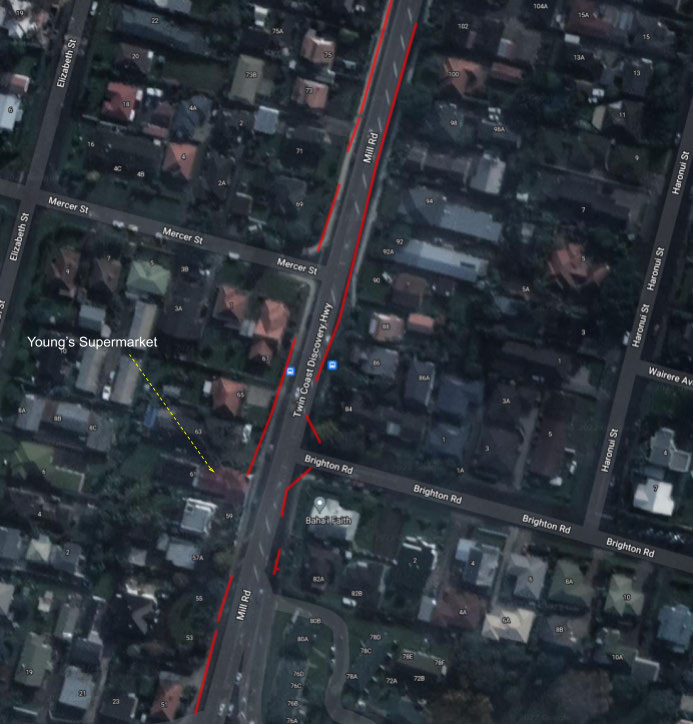 Satellite image showing the Spray Pump switched On (Red line) and Off (No line), on the 20th of
October 2022, Mil Road, Whanagarei.
Satellite image showing the Spray Pump switched On (Red line) and Off (No line), on the 20th of
October 2022, Mil Road, Whanagarei.
The device is connected to the vehicle by a permanent positive and negative power supply
from the vehicles battery, the ignition on is connected to the input 1, which allows the
software to report the vehicles activity (position, time and speed etc) immediately the
ignition is turned on or off. While the ignition is in the on position the GPS device reports
every 20 seconds or changes in direction by 15 degrees.
An extra input is connected to the electric spray pump on/off switch (Input 3). This allows
the GPS device to report immediately the input is switched on/off, and while it is on every
20 seconds, or change in direction of 15 degrees.
2

Both the ignition and input 3 activity can be shown on Fleetpin reports, the reports show
time and location that the inputs were turned on and off.
On the 20th of October 2021 the device appears to have been operating normally with the
power supply, inputs, satellite and mobile phone network signals all normal.
3

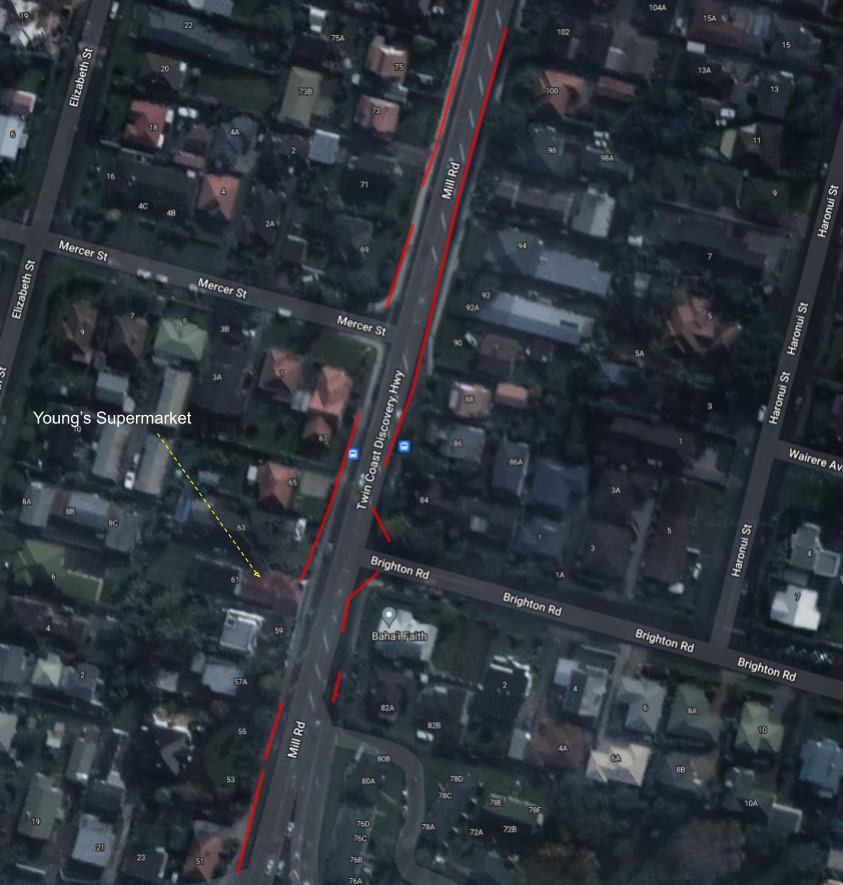
GPS Data
A solid line on a map represents the Spray Pump Switch was in the ON position, no line
indicates that the Spray Pump switch was in the OFF position.
Satellite image showing the Spray Pump switched On (Red line) and Off (No line), on the 20th of
October 2022, Mil Road, Whanagarei.
The Input report and associated image above shows that the Spray pump was switched;
● On, at the southern end of 51 Mil Road.
● Off, at the northern end of 53 Mil Road at a vehicle entrance.
(time on 13s)
4

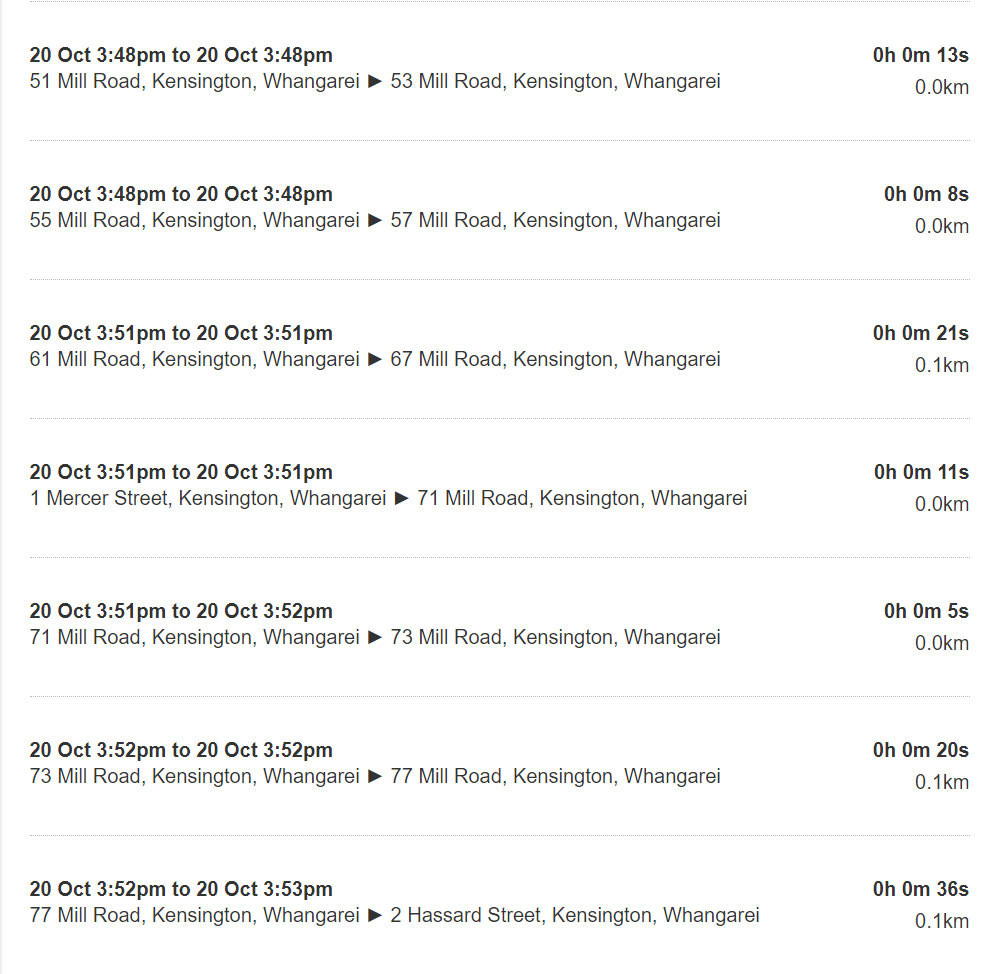
● On, at the southern end of 55 Mil Road at the same vehicle entrance mentioned
above.
● Off, at the northern end of 55 Mil Road.
(time on 8s)
● On, at the northern end of 61 Mil Road, northern end of Young’s Supermarket
● Off, in the middle of 67 Mil Road.
(time on 21s)
Excerpt from Fleetpin Input Report, showing Spray pump on times and locations.
5

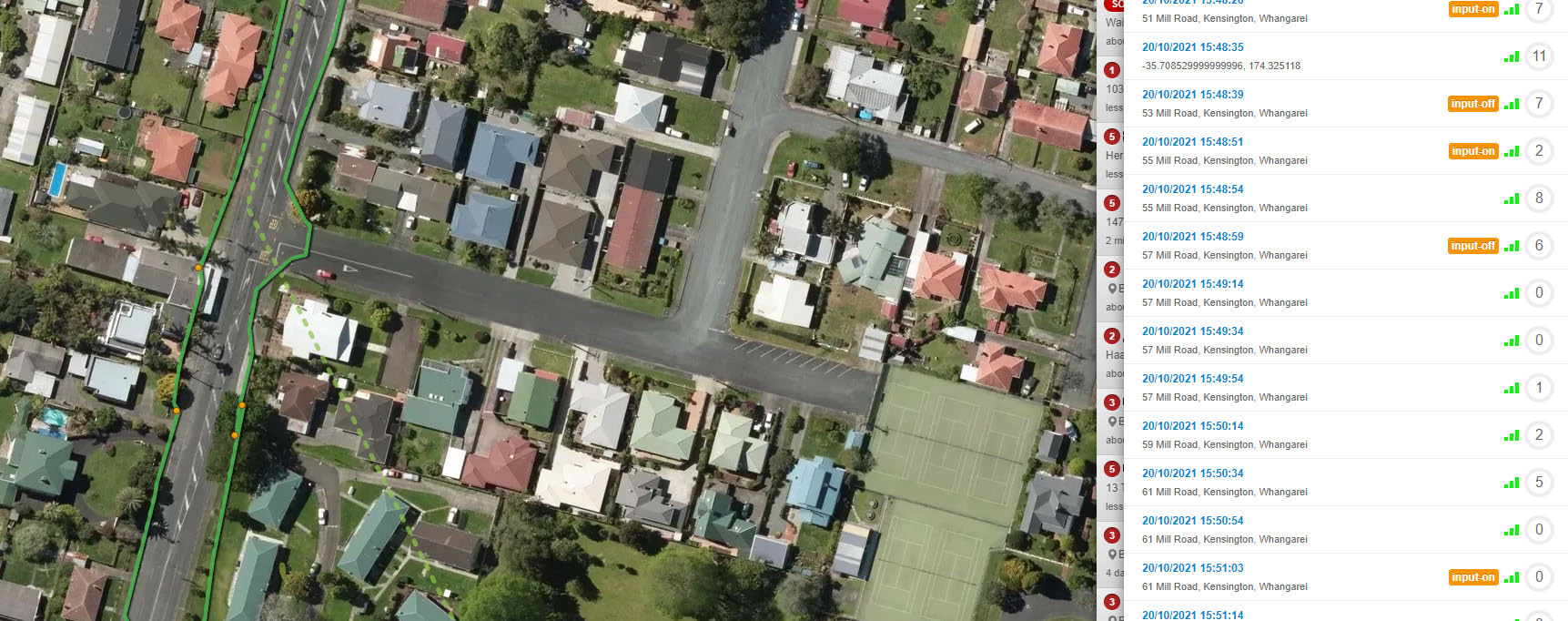
It is noted on the view that shows the track of the ATV using the ignition input, (input 1) that
the ATV appears to have fol owed the roadside kerb, even when the spray pump switch was
turned off. This is evidenced by the track curving into what appears to be the car parking
area outside Young's Supermarket, it is also noted by the yellow pins on the satellite image
that the vehicle was stopped momentarily at these pin positions.
Satellite image of track taken by ATV - yellow pins indicate where ATV stopped momentarily
with engine running.
6


Conclusion
Based upon the information obtained I have reached the fol owing opinions and
conclusions regarding the GPS information;
● The ATV machine is fitted with a GPS device that has the Spray Pump on/off switch
fitted to input 3.
● The device was operating correctly on the 20th of October 2021, in that all power
supply, inputs, satellite and phone signals were normal.
● The device positions and times provided by the device were within the CEP values
of 2.5m as per the device specifications each time input 3 (Spray pump switch) was
turned on and off.
● The information shows that input 3, (spray pump switch) was turned off from the
southern edge of 57a Mil Road, until the northern end of 61 Mil Road (Youngs
Supermarket), where the alleged incident occurred.
● The GPS information shows that the ATV appears to have fol owed the kerbline past
Young’s Supermarket even when the sprayer was turned off.
I have rendered the conclusions and opinions in this report based upon the information
obtained and my experience in the field of GPS Fleet Tracking. The opinions and
conclusions in this report are subject to change should further information become
available.
Author:
Todd McCormack
Director/CEO Fleetpin Ltd
Signed:
Date:
29/11/2022
7
s
ndice
7.0 Information Monsanto Science Direct
ppe
A
Page
32 of
32
Classification: Restricted
History of Glyphosate
Glyphosate was first created in 1950 by a Swiss chemist who worked for the pharmaceutical
company Cilag, but its use was rapidly abandoned due to the inability to find any pharmaceutical
application (Dill et al., 2010). Later, Cilag was acquired by Aldrich Chemicals and in 1966 glyphosate
was made available in their catalog as Article No. S39,860-8 (Aldrich Library of Rare Chemicals).
Glyphosate was tested for screening purposes by several companies for over a decade until some
biological properties were reported. A first patent was issued in 1964 for use of glyphosate as a metal
chelating and descaling agent (US Patent No. 3,160,632), in order to clean out mineral deposits in
pipes and boilers.
At that time, Monsanto Company was engaged in synthesizing water-softening agents. When these
compounds were tested as herbicides by Dr. Phil Hamm, he found that organo-phosphonates had a
herbicidal activity on perennial weeds (Dill et al., 2010). With the help of Dr. John Franz, they decided
to explore the herbicidal properties of organo-phosphonate derivatives. Glyphosate was synthesized
in May 1970 and was tested in a greenhouse in July of that year. This led to glyphosate being
patented as an herbicide in 1971 (US Patent No. 3,799,758) and introduced into the pesticides
market in 1974 as a pesticide active principle under the trade name “Roundup®.” Upon its
introduction, glyphosate quickly became the leading pesticide on the market. This position was
reinforced by a decrease in price when Monsanto's first patent expired in 1991 and sales of generic
glyphosate-based herbicide (GBH) preparations expanded.
A Pillar of Modern Agriculture
For over two decades after its introduction, the number and diversity of agricultural and nonfarm
uses of glyphosate has grown steadily (Benbrook, 2016). However, the global quantity used only
increased slowly because glyphosate has a nonselective, broad spectrum herbicidal action and thus
could only be sprayed to kill all vegetation (e.g., between rows in orchards, public or private parks,
cemeteries, gardens, and along roads and railway tracks). Agricultural uses were restricted to
postharvest application or late-season spraying when weeds escaped other control measures
(Benbrook, 2016). In some wet climate areas, wheat, oats, and other grains are sprayed late in the
growing season to facilitate harvest operations by speeding up crop drying (Benbrook, 2016). A total
0.36 million kilograms of glyphosate active ingredient were applied by farmers and ranchers in the
United States in 1974. The volume applied increased steadily, but not dramatically, through 1995, to
12.5 million kilograms (Benbrook, 2016).
Glyphosate sales and uses increased exponentially after 1996 with the introduction of Roundup
Ready crops, a series of new crop varieties (soybean, maize, canola, cotton, sugar beet) genetically
engineered (GE) to be sprayed with Roundup or other GBH without dying. The Roundup Ready
system not only aims to simplify weed management but also considerably increases the use of
Roundup and consequently the amount present in food and feed, where residues up to 500 mg/kg
are permitted. As Roundup Ready crops gained market share from 1996, agricultural applications of
glyphosate rose rapidly, reaching 36 million kilograms by 2000 in the United States (Benbrook,
2016). The average number of glyphosate applications, as well as the average quantity of glyphosate
sprayed per hectare on land planted to Roundup Ready crops, also escalated steadily. The average
number of glyphosate applications rose from 1.1 per crop year in 1996 to 1.52 in 2014, while the
one-time rate of application rose from 0.7 to 1.1 kg/ha in the same period (Benbrook, 2016).
Consequently glyphosate and its metabolite aminomethylphosphonic acid are present at relatively
high and increasing levels (over 1 ppm) in a high percentage of Roundup Ready soybeans (Benbrook,
2016).
The use of GBHs also expanded quickly due to the perception that glyphosate is rapidly degraded in
the environment. However, the half-life of glyphosate in water and soil is longer than previously
thought. The half-life of glyphosate in fields ranges between a few days to several months, or even a
year, depending on soil composition (Myers et al., 2016).
Overall, since 1974 in the United States, over 1.6 billion kilograms of glyphosate have been applied
(Benbrook, 2016), or 19% of the estimated global worldwide use of glyphosate (8.6 billion
kilograms). The use of GBHs is still steadily increasing. In 2014 farmers sprayed enough glyphosate to
apply 0.53 kg/ha on all cropland worldwide (Benbrook, 2016). Data published by the USDA, USGS,
and EPA show that approximately two-thirds of the total volume of GBH applied since 1974 has been
in the last decade (Benbrook, 2016).
The ubiquitous presence of glyphosate in food/water/air means that it is regularly ingested. It is
present virtually everywhere in the food chain. For instance, residue testing by the UK Food
Standards Agency conducted in October 2012 found glyphosate residues at or above 0.2 mg/kg in 27
out of 109 samples of bread (Myers et al., 2016). GBH residues also contaminate drinking water via
rainwater, surface runoff, and leaching into groundwater.
The real body burden of GBH residues in human populations is poorly characterized. Epidemiological
data on the body burden of glyphosate is very limited but evidence suggests that glyphosate and its
metabolites are widespread (Niemann et al., 2015). Urinary levels of 1–10 μg/L are typically found.
Although glyphosate is one of the most studied chemicals, controversy persists on its toxicological
profile and on the health risks arising from exposure to the residues of glyphosate commercial
formulations (Myers et al., 2016).
Taken from
https://www.sciencedirect.com/topics/earth-and-planetary-sciences/glyphosate





























